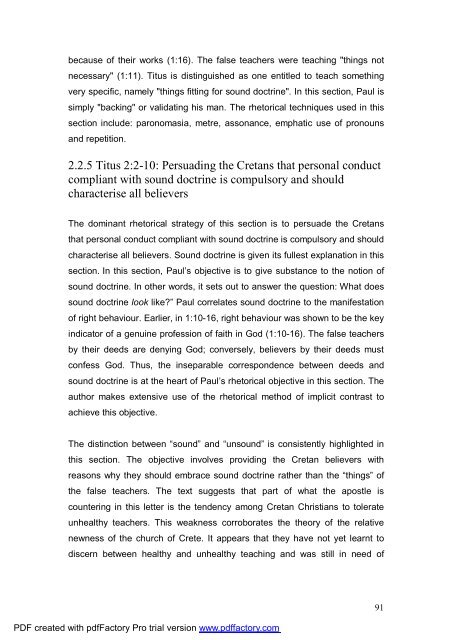A Text centred rhetorical analysis of Paul's Letter to Titus
A Text centred rhetorical analysis of Paul's Letter to Titus
A Text centred rhetorical analysis of Paul's Letter to Titus
Create successful ePaper yourself
Turn your PDF publications into a flip-book with our unique Google optimized e-Paper software.
ecause <strong>of</strong> their works (1:16). The false teachers were teaching "things not<br />
necessary" (1:11). <strong>Titus</strong> is distinguished as one entitled <strong>to</strong> teach something<br />
very specific, namely "things fitting for sound doctrine". In this section, Paul is<br />
simply "backing" or validating his man. The <strong>rhe<strong>to</strong>rical</strong> techniques used in this<br />
section include: paronomasia, metre, assonance, emphatic use <strong>of</strong> pronouns<br />
and repetition.<br />
2.2.5 <strong>Titus</strong> 2:2-10: Persuading the Cretans that personal conduct<br />
compliant with sound doctrine is compulsory and should<br />
characterise all believers<br />
The dominant <strong>rhe<strong>to</strong>rical</strong> strategy <strong>of</strong> this section is <strong>to</strong> persuade the Cretans<br />
that personal conduct compliant with sound doctrine is compulsory and should<br />
characterise all believers. Sound doctrine is given its fullest explanation in this<br />
section. In this section, Paul’s objective is <strong>to</strong> give substance <strong>to</strong> the notion <strong>of</strong><br />
sound doctrine. In other words, it sets out <strong>to</strong> answer the question: What does<br />
sound doctrine look like?” Paul correlates sound doctrine <strong>to</strong> the manifestation<br />
<strong>of</strong> right behaviour. Earlier, in 1:10-16, right behaviour was shown <strong>to</strong> be the key<br />
indica<strong>to</strong>r <strong>of</strong> a genuine pr<strong>of</strong>ession <strong>of</strong> faith in God (1:10-16). The false teachers<br />
by their deeds are denying God; conversely, believers by their deeds must<br />
confess God. Thus, the inseparable correspondence between deeds and<br />
sound doctrine is at the heart <strong>of</strong> Paul’s <strong>rhe<strong>to</strong>rical</strong> objective in this section. The<br />
author makes extensive use <strong>of</strong> the <strong>rhe<strong>to</strong>rical</strong> method <strong>of</strong> implicit contrast <strong>to</strong><br />
achieve this objective.<br />
The distinction between “sound” and “unsound” is consistently highlighted in<br />
this section. The objective involves providing the Cretan believers with<br />
reasons why they should embrace sound doctrine rather than the “things” <strong>of</strong><br />
the false teachers. The text suggests that part <strong>of</strong> what the apostle is<br />
countering in this letter is the tendency among Cretan Christians <strong>to</strong> <strong>to</strong>lerate<br />
unhealthy teachers. This weakness corroborates the theory <strong>of</strong> the relative<br />
newness <strong>of</strong> the church <strong>of</strong> Crete. It appears that they have not yet learnt <strong>to</strong><br />
discern between healthy and unhealthy teaching and was still in need <strong>of</strong><br />
PDF created with pdfFac<strong>to</strong>ry Pro trial version www.pdffac<strong>to</strong>ry.com<br />
91

















